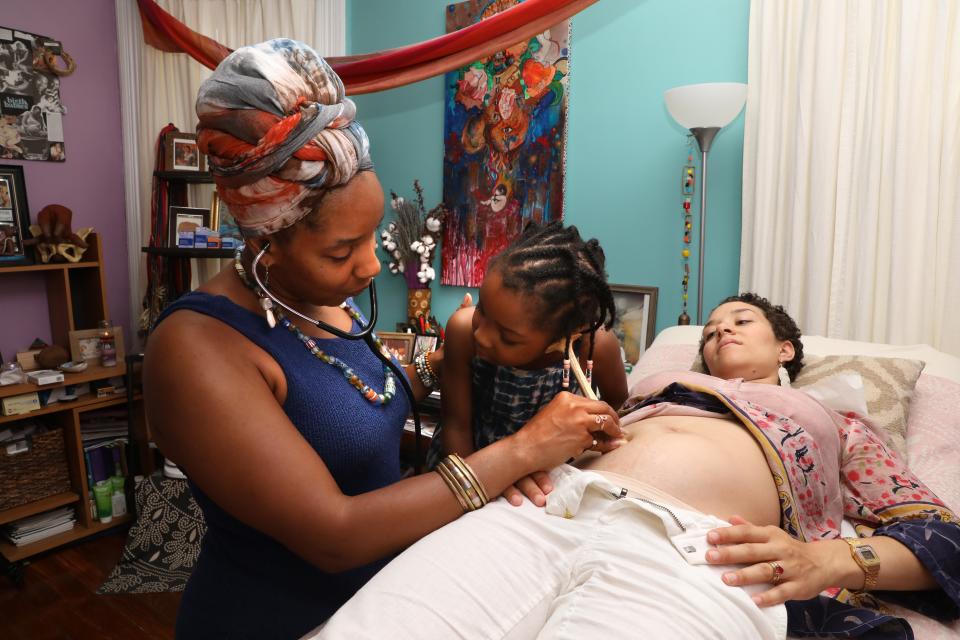NJ childbirth report: C-sections, maternal deaths down, but racial disparities remain
The number of cesarean sections and serious maternal complications around childbirth have decreased in recent years in New Jersey, according to a new report, a welcome development for a state that has had one of the highest maternal death rates in the nation.
But there still remains a significant racial gap in maternal care, especially among Black women, who are more likely to develop serious complications than white women, including hypertension and hemorrhaging. Asian and Hispanic women also have higher rates.
The report, titled "Path To Progress," was released last week by the New Jersey Hospital Association and comes amid calls in recent years to reduce the high death rate among women giving birth, an issue championed by first lady Tammy Murphy.
Hospital reforms "demonstrate that our focus on maternal and infant health can make a real impact on lives saved," Murphy said in a statement.
Despite being a state with one of the highest per capita income levels — and one that bills itself as an educational powerhouse with some of the top hospitals in the nation — New Jersey has had one of the country's worst overall maternal mortality rates.

A USA Today analysis of data ranked New Jersey fifth-worst in the nation, with 36.2 maternal deaths per 100,000 births from 2012 to 2016. It ranked number 14 a few years later, with a maternal death rate of 24.1 per 100,000 births from 2018 to 2020, according to the Kaiser Family Foundation.
New Jersey hospitals began a program in 2017 to tackle the problem by focusing on three key areas, including the rate of C-sections, which in 2016 made up about a third of all deliveries — one of the highest rates in the nation.
Two other areas were high rates of blood pressure complications and excessive bleeding during pregnancy, labor, delivery or postpartum. With federal funding, the hospitals partnered and adopted uniform standards of care in an effort to improve.
From 2016 to 2021, the rate of C-sections dropped from 32.31 per 100 births to 27.77, according to the report. Hospital executives say that drop averted 10,000 unnecessary C-sections.
The rate of hypertensive disorders in pregnancy declined from 8.5 per 100 births in 2016 to 6 in 2021. The rate of obstetric hemorrhage fell from 8.25 per 100 births in 2016 to 7 in 2021.
The nonprofit group Partnership for Maternal and Child Health of Northern New Jersey, which helps pregnant women of all racial and socioeconomic backgrounds across eight counties, said the numbers are encouraging. But the racial disparities remain and need an enormous effort to correct.
A series of articles by the USA TODAY Network in 2020 called "Birthing While Black" documented significant problems in care and outcome among Black pregnant women, including higher mortality rates, C-section rates and complications than other races. Health Department data shows black women had almost double the rate of pregnancy-related death than white women in 2017 and 2018.
"Part of the reason why it’s not getting fixed is that it’s not solely a medical and clinical issue," said Carolyn DeBoer, the organization's chief strategy officer. "A hospital has a mom for 48 or 72 hours. They're not going to solve issues of poverty, housing, education, discrimination right then and there."
DeBoer said increased prenatal care along with education about pregnancy, delivery and postpartum issues are a must in battling the discrepancies. She said services such as community doulas — who advise and advocate for pregnant women — can make a big difference, along with social workers who can try to help them navigate other parts of their life. Group discussions on everything from nutrition and stress management to labor, delivery, breastfeeding and infant care can have a real impact.
Getting C-section rates down further will require even more changes, advocates have said. Hospitals still receive higher payments for cesarean section births. New Jersey also has no limits on compensatory damages in medical malpractice cases, which may force doctors to veer toward a C-section when there is even the slightest hint of a possible complication with vaginal delivery, DeBoer said.
The report said a combination of better methods for monitoring the fetal heart rate and earlier intervention if problems are detected has helped lead to more vaginal births.
"Everyone has recognized that an unnecessary C-section means that you’re pretty much in this club for good on successive pregnancies," DeBoer said. "And that can lead to other complications. So it's an issue that if you stop C-sections, some of the complications will probably go down."
Racial discrepancies persist
The rate in 2020 of pregnant women giving birth via C-sections by race per 100 live childbirths:
White: 23.2
Black: 28.8
Asian: 29.0
Hispanic: 24.8
The rate in 2021 of pregnant women with chronic hypertension, pregnancy-related hypertension and preeclampsia:
White: 5.1
Black: 7.4
Asian: 5.6
Hispanic: 6.0
The rate in 2021 of pregnant women who had obstetric hemorrhage — significant blood loss during pregnancy, but especially during labor, vaginal and C-section delivery and postpartum:
White: 6.3
Black: 9.9
Asian: 8.2
Hispanic: 5.7
Source: New Jersey Hospital Association "Path To Progress" Report
This article originally appeared on NorthJersey.com: C-sections and maternal deaths down in NJ but race disparities remain

